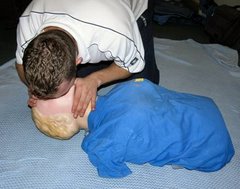Chest Pain
Unless there is obvious evidence to the contrary (eg. someone has just been winded playing sport) always assume the worst when it comes to chest pain - treat as a heart attack.
Angina is another possibility. If the casualty is having an angina attack they will usually know about their condition, have medication and tell the first aider about it.
A heart attack occurs when the coronary artery, which supplies the heart muscle with oxygenated blood, becomes occluded - this causes the muscle beyond the occlusion to die. Angina is due to temporary narrowing of the coronary artery - this results in less oxygenated blood getting to the heart muscle.
Signs and symptoms:
The casualty will complain of persistent 'crushing' chest pain maybe radiating to their neck, jaw and arms. They will normally be breathless, have pale 'ashen' skin and possibly blueness of the lips (called cyanosis). Their pulse will be rapid, weak and irregular. It is also common for the casualty to be cold and clammy to the touch. Vomiting and nausea are also common symptoms.
Treatment:
All Cases: Sit the casualty down in the 'W' position.
Angina: If the casualty has medication for their condition help them to take it.
Heart Attack: Dial 999 ASAP.
Angina: If the casualty's condition doesn't ease within a few minutes of them taking their medication call 999.
All Cases: If possible give an adult casualty (not a child) an aspirin tablet to slowly chew. Monitor the casualty closely until help arrives - keep a note of pulse and respiration rates. Be prepared to give CPR if the casualty stops breathing (see Adult Basic Life Support).
Angina is another possibility. If the casualty is having an angina attack they will usually know about their condition, have medication and tell the first aider about it.
A heart attack occurs when the coronary artery, which supplies the heart muscle with oxygenated blood, becomes occluded - this causes the muscle beyond the occlusion to die. Angina is due to temporary narrowing of the coronary artery - this results in less oxygenated blood getting to the heart muscle.
Signs and symptoms:
The casualty will complain of persistent 'crushing' chest pain maybe radiating to their neck, jaw and arms. They will normally be breathless, have pale 'ashen' skin and possibly blueness of the lips (called cyanosis). Their pulse will be rapid, weak and irregular. It is also common for the casualty to be cold and clammy to the touch. Vomiting and nausea are also common symptoms.
Treatment:
All Cases: Sit the casualty down in the 'W' position.
Angina: If the casualty has medication for their condition help them to take it.
Heart Attack: Dial 999 ASAP.
Angina: If the casualty's condition doesn't ease within a few minutes of them taking their medication call 999.
All Cases: If possible give an adult casualty (not a child) an aspirin tablet to slowly chew. Monitor the casualty closely until help arrives - keep a note of pulse and respiration rates. Be prepared to give CPR if the casualty stops breathing (see Adult Basic Life Support).




